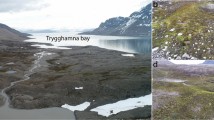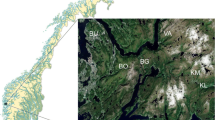Abstract
Glacier surfaces have a surprisingly complex ecology. Cryoconite holes contain diverse invertebrate communities, while other invertebrates, such as Collembola, often graze on algae and windblown dead organic material on the glacier surface. Glacier mice (ovoid unattached moss balls) occur on some glaciers worldwide. Studies of these glacier mice have concentrated on their occurrence and mode of formation. There are no reports of the invertebrate communities. But, such glacier mice may provide a suitable favourable habitat and refuge for a variety of invertebrate groups to colonise the glacier surface. Here, we describe the invertebrate fauna of the glacier mice (moss balls) of the Falljökull, Iceland. The glacier mice were composed of Racomitrium sp. and varied in size from 8.0 to 10.0 cm in length. All glacier mice studied contained invertebrates. Two species of Collembola were present. Pseudisotoma sensibilis (Tullberg, 1876) was numerically dominant with between 12 and 73 individuals per glacier mouse, while Desoria olivacea (Tullberg, 1871) occurred but in far lower numbers. Tardigrada and Nematoda had mean densities of approximately 200 and 1,000, respectively. No Acari, Arachnida or Enchytraeidae were observed, which may be related to the difficulty these groups have in colonising the glacier mice. We suggest that glacier mice provide an unusual environmentally ameliorated microhabitat for an invertebrate community dwelling on a glacial surface. The glacier mice thereby enable an invertebrate fauna to colonise an otherwise largely inhospitable location with implications for carbon flow in the system.







Similar content being viewed by others
References
Anesio AM, Hodson AJ, Fritz A, Psenner R, Sattler B (2009) High microbial activity on glaciers: importance to the global carbon cycle. Glob Change Biol 15:955–960
Babenko A, Fjellberg A (2006) Collembola Septentrionala. A catalogue of springtails of the Arctic regions. KMK Scientific Press Ltd, Moscow
Birkemoe T, Leinaas HP (1999) Reproductive biology of the Arctic collembolan Hypogastrura tullbergi. Ecography 22:31–39
Birkemoe T, Sømme LS (1998) Population dynamics of two collembolan species in an Arctic tundra. Pedobiologia 42:131–145
Block W, Harrisson PM, Vannier G (1990) A comparative-study of patterns of water-loss from two Antarctic springtails (Insecta, Collembola). J Insect Physiol 36:181–187
Chenet M, Roussel E, Jomelli V, Grancher D (2010) Asynchronous Little Ice Age glacial maximum extent in southeast Iceland. Geomorphology 114:253–260
Chenet M, Roussel E, Jomelli V, Grancher D, Cooley D (2011) A response to the commentary of M. Dąbski about the paper ‘Asynchronous Little Ice Age glacial maximum extent in southeast Iceland’. Geomorphology 128:103–104
Coulson SJ (2007) The terrestrial and freshwater invertebrate fauna of the high Arctic archipelago of Svalbard. Zootaxa 1448:41–58
Coulson SJ, Hodkinson ID, Strathdee AT, Bale JS, Block W, Worland MR, Webb NR (1993) Simulated climate change: the interaction between vegetation type and microhabitat temperatures at Ny-Ålesund, Svalbard. Polar Biol 13:67–70
Dąbski M (2010) A commentary to ‘Asynchronous Little Ice Age glacial maximum extent in southeast Iceland’ by Chenet et al. (Geomorphology 114 (2010) 253–260); a case of Fláajökull. Geomorphology 120:365–367
Dastych H (1985) West Spitsbergen Tardigrada. Acta Zool Cracov 28:169–214
De Smet WH, Van Rompu EA (1994) Rotifera and Tardigrada from some cryoconite holes on a Spitsbergen (Svalbard) glacier. Belg J Zool 124:27–37
De Smet WH, Van Rompu EA, Beyens L (1988) Contribution to the Rotifera and aquatic Tardigrada of Edgeoya (Svalbard). Fauna Norv Ser A 9:19–30
Eythórsson J (1951) Correspondence. Jőkla-mýs. J Glaciol 1:503
Fjellberg A (2007a) Icelandic Collembola. Revised checklist and general comments. Insect Syst Evol 64:45–60
Fjellberg A (2007b) The Collembola of Fennoscandia and Denmark. part II: entomobryomorpha and Symphypleona. Fauna Entomol Scand 42:1–264
Fjellberg A (2010) Cryophilic Isotomidae (Collembola) of the Northwestern Rocky mountains, U.S.A. Zootaxa 2513:27–49
Fjellberg A, Bernard EC (2009) Review of Agrenia Borner, 1906 with descriptions of four new species from North America (Collembola, Isotomidae). Zootaxa 2306:17–28
Gjelstrup P (2000) Soil mites and collembolans on Surtsey, Iceland, 32 years after the eruption. Surtsey Res 11:43–50
Graham DJ, Midgley NG (2000) Graphical representation of particle shape using triangular diagrams: an excel spreadsheet method. Earth Surf Proc Land 25:1473–1477
Hartzell PL, Shain DH (2009) Glacier ice worms. In: Shain DH (ed) Annelids in modern biology. Wiley, Hoboken, pp 301–313
Hartzell PL, Nghiem JV, Richio KJ, Shain DH (2005) Distribution and phylogeny of glacier ice worms (Mesenchytraeus solifugus and Mesenchytraeus solifugus rainierensis). Can J Zool 83:1206–1213
Hawes TC, Worland MR, Convey P, Bale JS (2007) Aerial dispersal of springtails on the Antarctic Peninsula: implications for local distribution and demography. Antarct Sci 19:3–10
Heusser CJ (1972) Polsters of the moss Drepanocladius berggrenii on Gilkey Glacier, Alaska. Bull Torrey Bot Club. 99:34–36
Hodkinson ID, Healey V, Coulson S (1994) Moisture relationships of the High Arctic collembolan Onychiurus arcticus. Physiol Entomol 19:109–114
Hodson AJ, Mumford PN, Kohler J, Wynn PM (2005) The High Arctic glacial ecosystem: new insights from nutrient budgets. Biogeochemistry 72:233–256
Hopkin SP (1997) Biology of the Springtails. Insecta: Collembola. Oxford University Press, Oxford
Jonsdottir IS (2005) Terrestrial ecosystems on Svalbard: heterogeneity, complexity and fragility from an Arctic Island perspective. P R Irish Acad B 105:155–165
Kopeszki H (2000) Auf der Suche nach rotten Gletscherflöhen. Funde hochalpiner Springschwänze (Collembola). Vorarlberger Naturschau 8:133–144
Krantz GW, Walter DE (2009) A manual of acarology, 3rd edn. Texas Tech University Press, Lubback
Makkonen M, Berg MP, van Hal JR, Callaghan TV, Press MC, Aerts R (2011) Traits explain the responses of a sub-arctic Collembola community to climate manipulation. Soil Biol Biochem 43:377–384
Perez FL (1991) Ecology and morphology of globular mosses of Grimmia longirostris in the Paramo de Piedras Blancas, Venezuelan Andes. Arct Antarct Alp Res 23:133–148
Porazinska DL, Fountain AG, Nylen TH, Tranter M, Virginia RA, Wall DH (2004) The biodiversity and biogeochemistry of cryoconite holes from McMurdo dry valley glaciers. Arct Antarct Alp Res 36:84–91
Porter PR, Evans AJ, Hodson AJ, Lowe AT, Crabtree MD (2008) Sediment-moss interactions on a temperate glacier: Falljökull, Iceland. Ann Glaciol 48:25–31
Pugh PJA, McInnes SJ (1998) The origin of Arctic terrestrial and freshwater tardigrades. Polar Biol 19:177–182
Säwström C, Mumford P, Marshall W, Hodson A, Laybourn-Parry J (2002) The microbial communities and primary productivity of cryoconite holes in an Arctic glacier Svalbard 79°N. Polar Biol 25:591–596
Scherrer D, Korner C (2010) Infra-red thermometry of alpine landscapes challenges climatic warming projections. Glob Change Biol 16:2602–2613
Shacklette HT (1966) Unattached moss polsters on Amchitka Island, Alaska. Bryologist 69:346–352
Southwood TRE, Henderson PA (2000) Ecological methods. Blackwell, Oxford
Walter DE, Procter HC (1999) Mites: ecology, evolution and behavior. CABI International, Oxford
Wharton RA, McKay CP, Simmons GM, Parker BC (1985) Cryoconite holes on glaciers. Bioscience 35:449–503
Acknowledgments
Fanny Dommanget for invaluable help in the laboratory and Arne Fjellberg Entomological Research for identification of the Collembola. Michael Stech and Hans Kruijer from the National Herbarium of the Netherlands, University of Leiden, for identifying the moss and checking synonyms. Guðrún Þórunn Gísladóttir assisted with the provision of Icelandic Meteorological Office data sets. NGM received funding from Nottingham Trent University to undertake fieldwork in Iceland and was assisted by Oz Godden, Karen Mather and Nikki Sandercock. Mike Pemulis is thanked for advice on the use of the dot product operation. We are also grateful to three anonymous reviewers and the Editor for their constructive comments on the manuscript.
Author information
Authors and Affiliations
Corresponding author
Rights and permissions
About this article
Cite this article
Coulson, S.J., Midgley, N.G. The role of glacier mice in the invertebrate colonisation of glacial surfaces: the moss balls of the Falljökull, Iceland. Polar Biol 35, 1651–1658 (2012). https://doi.org/10.1007/s00300-012-1205-4
Received:
Revised:
Accepted:
Published:
Issue Date:
DOI: https://doi.org/10.1007/s00300-012-1205-4




